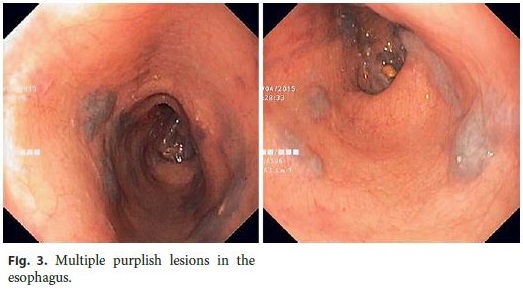Blue rubber bleb nevus syndrome brbns is a rare disorder characterized by multiple venous malformations affecting the skin and internal viscera.
Blue rubber nevus syndrome skin.
Blue rubber bleb nevus syndrome brbns is a rare condition that is characterized by numerous malformations of the venous system that significantly involve the skin and visceral organs.
Blue rubber bleb nevus syndrome brbns is a rare blood vessel vascular disorder that affects the skin and internal organs of the body.
However it was later made famous in 1958 by william bennett bean for which the disease has been termed bean syndrome later referenced as.
The disease is characterized by the presence of fluid filled blisters as visible circumscribed chronic lesions nevus it was described by william bean in 1958.
Blue rubber bleb nevus syndrome is a condition in which the blood vessels do not develop properly in an area of the skin or other body organ particularly the intestines.
Bean first used the term blue rubber bleb nevus syndrome brbns which was derived from cutaneous hemangiomas having the feeling and look of rubber nipples.
Blue rubber bleb nevus syndrome brbns sometimes called bean syndrome is a rare congenital vascular anomaly in which malformed veins or blebs appear on the skin and surfaces of internal organs.
It was first described by gascoyen in 1806 but in 1958 william bennet bean coined the term blue rubber nevus syndrome for its color and consistency 1 2 only about 200 hundred cases were.
These small purple lesions are particularly common in the gastrointestinal gi tract.
The malformed blood vessels appear as a spot or lesion called a nevus.
The tendency to the syndrome is passed on to half of one s children.
There is frequently a family history with autosomal dominant inheritance i e.
Brbns is an uncommon disorder that is characterized by cutaneous and gi hemangiomas with.
Gascoyen first reported the association of cutaneous nevi and intestinal lesions with gastrointestinal gi bleeding in 1860.
Lesions in the gastrointestinal tract frequently become apparent.
Given the clinical and imagiological features we established the diagnosis of a sporadic type of blue rubber bleb nevus syndrome brbns.
This condition was initially discovered in 1860 by gascoyen.
Blue rubber bleb nevus syndrome is a rare disorder that consists mainly of abnormal blood vessels affecting the skin or internal organs usually the gastrointestinal tract.
Dermatological lesions which are the first clinically visible manifestations appear as skin colored compressible protub.
Multiple distinctive skin lesions are usually characteristic of this disorder and are often present at birth or present during early childhood.
The blue rubber bleb naevus syndrome or bean syndrome is a rare form of venous malformation in which there are skin and gastrointestinal tract lesions.

